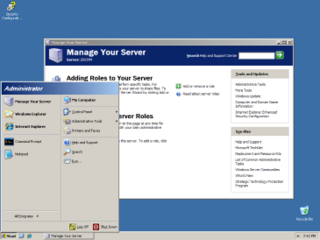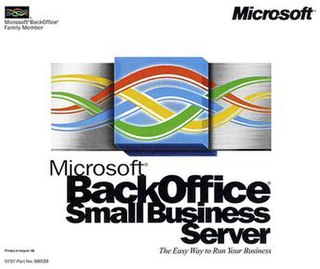Microsoft Windows was announced by Bill Gates on 10 November 1983, 2 years before it was first released. Microsoft introduced Windows as a graphical user interface for MS-DOS, which had been introduced two years earlier. The product line evolved in the 1990s from an operating environment into a fully complete, modern operating system over two lines of development, each with their own separate codebase.
Microsoft Windows is a product line of proprietary graphical operating systems developed and marketed by Microsoft. It is grouped into families and sub-families that cater to particular sectors of the computing industry – Windows (unqualified) for a consumer or corporate workstation, Windows Server for a server and Windows IoT for an embedded system. Defunct families include Windows 9x, Windows Mobile, Windows Phone, and Windows Embedded Compact.
Systems Network Architecture (SNA) is IBM's proprietary networking architecture, created in 1974. It is a complete protocol stack for interconnecting computers and their resources. SNA describes formats and protocols but, in itself, is not a piece of software. The implementation of SNA takes the form of various communications packages, most notably Virtual Telecommunications Access Method (VTAM), the mainframe software package for SNA communications.

Windows Server 2003, codenamed "Whistler Server", is the sixth version of the Windows Server operating system produced by Microsoft. It is part of the Windows NT family of operating systems and was released to manufacturing on March 28, 2003 and generally available on April 24, 2003. Windows Server 2003 is the successor to the Server editions of Windows 2000 and the predecessor to Windows Server 2008. An updated version, Windows Server 2003 R2, was released to manufacturing on December 6, 2005. Windows Server 2003 is based on Windows XP.

Microsoft IIS is an extensible web server created by Microsoft for use with the Windows NT family. IIS supports HTTP, HTTP/2, HTTP/3, HTTPS, FTP, FTPS, SMTP and NNTP. It has been an integral part of the Windows NT family since Windows NT 4.0, though it may be absent from some editions, and is not active by default. A dedicated suite of software called SEO Toolkit is included in the latest version of the manager. This suite has several tools for SEO with features for metatag / web coding optimization, sitemaps / robots.txt configuration, website analysis, crawler setting, SSL server-side configuration and more.

Server Message Block (SMB) is a communication protocol used to share files, printers, serial ports, and miscellaneous communications between nodes on a network. On Microsoft Windows, the SMB implementation consists of two vaguely named Windows services: "Server" and "Workstation". It uses NTLM or Kerberos protocols for user authentication. It also provides an authenticated inter-process communication (IPC) mechanism.

In computing, a service pack comprises a collection of updates, fixes, or enhancements to a software program delivered in the form of a single installable package. Companies often release a service pack when the number of individual patches to a given program reaches a certain (arbitrary) limit, or the software release has shown to be stabilized with a limited number of remaining issues based on users' feedback and bug reports. In large software applications such as office suites, operating systems, database software, or network management, it is not uncommon to have a service pack issued within the first year or two of a product's release. Installing a service pack is easier and less error-prone than installing many individual patches, even more so when updating multiple computers over a network, where service packs are common.
Remote Desktop Protocol (RDP) is a proprietary protocol developed by Microsoft Corporation which provides a user with a graphical interface to connect to another computer over a network connection. The user employs RDP client software for this purpose, while the other computer must run RDP server software.

Windows NT 4.0 is a major release of the Windows NT operating system developed by Microsoft and oriented towards businesses. It is the direct successor to Windows NT 3.51, and was released to manufacturing on July 31, 1996, and then to retail in August 24, 1996, with the Server versions released to retail in September 1996.

Windows NT 3.1 is the first major release of the Windows NT operating system developed by Microsoft, released on July 27, 1993.

Windows NT 3.51 is a major release of the Windows NT operating system developed by Microsoft and oriented towards businesses. It is the third version of Windows NT and was released on May 30, 1995, eight months following the release of Windows NT 3.5. The most significant enhancement offered in this release was that it provides client/server support for inter-operating with Windows 95, which was released almost three months after NT 3.51. Windows NT 4.0 became its successor a year later. Mainstream support for Windows NT 3.51 Workstation ended on December 31, 2000, and extended support ended on December 31, 2001, while Windows NT 3.51 Server mainstream support ended on September 30, 2000, followed by extended support on September 30, 2002. Both editions were succeeded by Windows NT 4.0 Workstation and Windows NT 4.0 Server, respectively.

Microsoft Project is project management software product, developed and sold by Microsoft. It is designed to assist a project manager in developing a schedule, assigning resources to tasks, tracking progress, managing the budget, and analyzing workloads.
Microsoft Servers is a discontinued brand that encompasses Microsoft software products for server computers. This includes the Windows Server editions of the Microsoft Windows operating system, as well as products targeted at the wider business market. Microsoft has since replaced this brand with Microsoft Azure, Microsoft 365 and Windows 365.

Windows Server Essentials is an integrated server suite from Microsoft for businesses with no more than 25 users or 50 devices. It includes Windows Server, Exchange Server, Windows SharePoint Services, and Microsoft Outlook. Application server technologies are tightly integrated to provide and offer management benefits such as integrated setup, enhanced monitoring, Remote Web Workplace, a unified management console, and remote access.

Microsoft Forefront Threat Management Gateway, formerly known as Microsoft Internet Security and Acceleration Server, is a discontinued network router, firewall, antivirus program, VPN server and web cache from Microsoft Corporation. It ran on Windows Server and works by inspecting all network traffic that passes through it.

Microsoft BackOffice Server is a discontinued computer software package featuring Windows NT Server and other Microsoft server products that ran on NT Server. It was marketed during the 1990s and early 2000s for use in branch operations and for small businesses to run their back office operations. The small business edition of BackOffice Server was released for versions 4.0 and 4.5. In 2000 it was spun off from the "BackOffice" brand, becoming a variant of Windows Server branded as Windows Small Business Server. BackOffice Server itself was discontinued on October 1, 2001.
CVSNT is a version control system compatible with and originally based on Concurrent Versions System (CVS), but whereas that was popular in the open-source world, CVSNT included features designed for developers working on commercial software including support for Windows, Active Directory authentication, reserved branches/locking, per-file access control lists and Unicode filenames. Also included in CVSNT were various RCS tools updated to work with more recent compilers and compatible with CVSNT.
Windows NT is a proprietary graphical operating system produced by Microsoft as part of its Windows product line, the first version of which, Windows NT 3.1, was released on July 27, 1993. Originally made for the workstation, office, and server markets, the Windows NT line was made available to consumers with the release of Windows XP in 2001. The underlying technology of Windows NT continues to exist to this day with incremental changes and improvements, with the latest version of Windows based on Windows NT being Windows 11 in 2021.

Microsoft started development on the .NET Framework in the late 1990s originally under the name of Next Generation Windows Services (NGWS). By late 2001 the first beta versions of .NET Framework 1.0 were released. The first version of .NET Framework was released on 13 February 2002, bringing managed code to Windows NT 4.0, 98, 2000, ME and XP.
The history of Microsoft SQL Server begins with the first Microsoft SQL Server database product – SQL Server v1.0, a 16-bit relational database for the OS/2 operating system, released in 1989.











